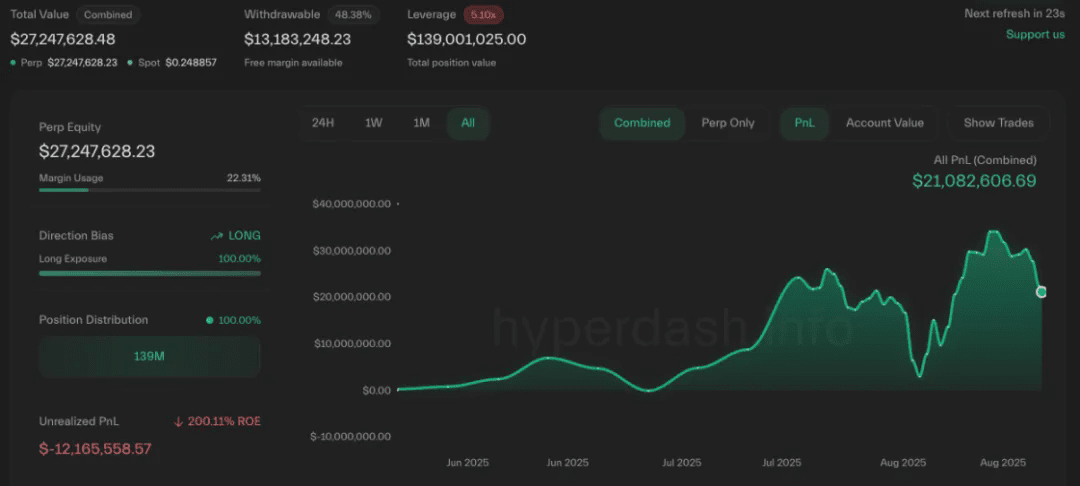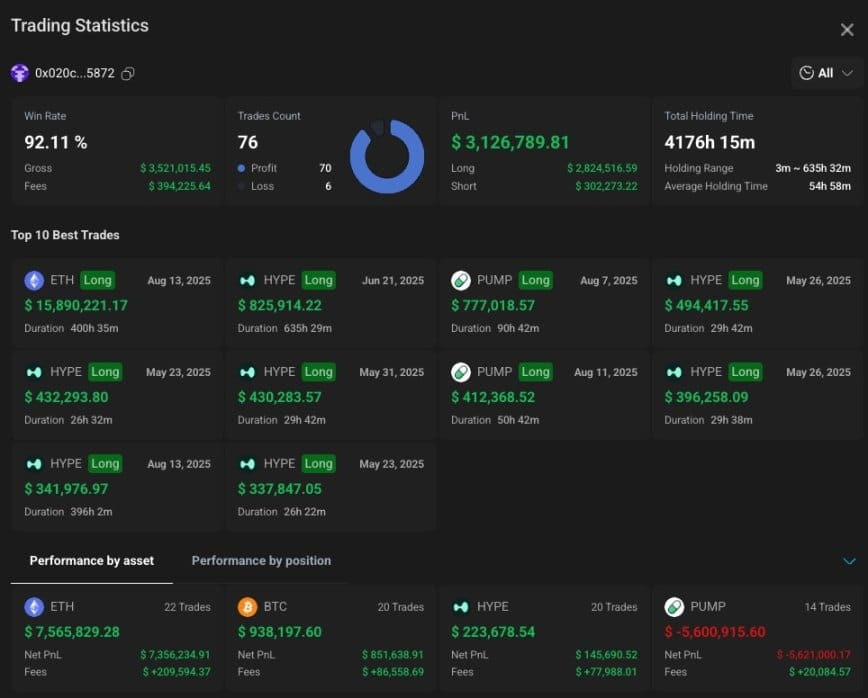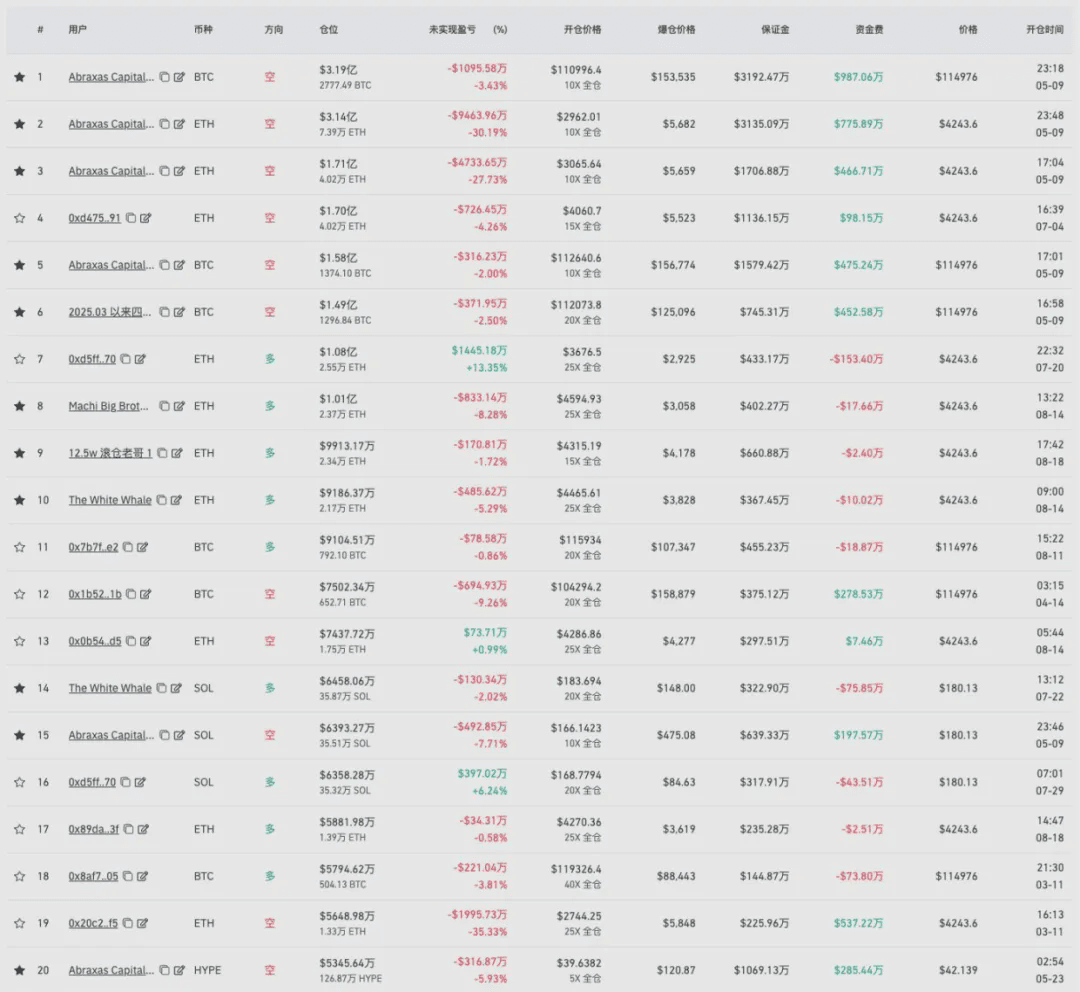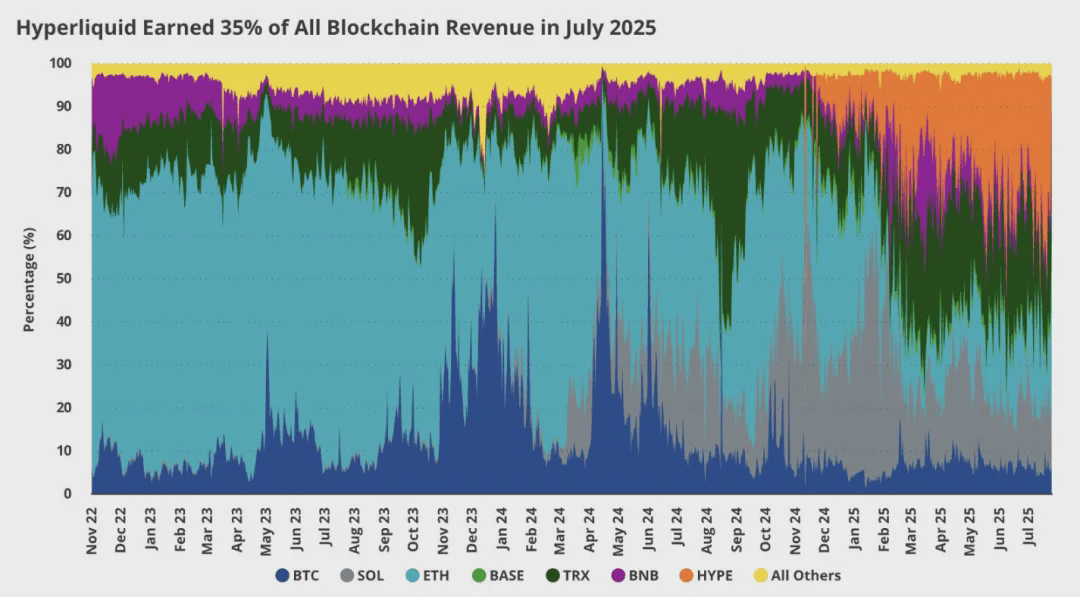
After initially making large purchases of blue-chip projects like Bored Ape Yacht Club (BAYC) and Azuki in the NFT market, in May 2025, Taiwanese musician Huang Licheng (nicknamed 'Machi Big Brother') began to shift towards the decentralized contract platform Hyperliquid, leaving behind a series of notable trading records in just a few months.
In the trading data from Hyperliquid, Huang Licheng's investment trajectory shows distinct roller coaster characteristics. Overall, his win rate is as high as 92.11%, with 70 profitable trades out of 76 and only 6 losses.
If observed from a more macroscopic yield curve, his account reached a floating profit peak of 35 million USD in early August 2025, but just a few days later, amid market correction, the net value fell to less than 3 million USD on August 3, almost completely retracting previous profits.

Huang Licheng's account curve swings significantly between peaks and troughs, reflecting a typical characteristic of high-leverage players: the potential for quick wealth but equally a risk of returning to the starting point at any moment.
Machi Big Brother's contract trajectory on Hyperliquid
On May 16, according to monitoring by Lookonchain, Taiwanese singer Huang Licheng's address (Machi Big Brother) deposited 6.04 million USDC into the Hyperliquid account. In the first week, there were a total of 7 trades, mainly concentrated on long positions in ETH and HYPE, all of which were profitable, netting 669,600 USD.
Subsequently, he expanded his capital to 6.7 million USD, purchasing 218,866 HYPE at an average price of 30.63 USD and choosing to stake. Within a week, the total amount grew to 8.2 million USD, realizing over 2.1 million USD in profits.
At the end of May, he continued to increase his positions, establishing long positions when ETH was around 2,654 USD, while also expanding his HYPE positions. From June to July, as the market rose, his floating profits rapidly increased, reaching a floating profit of 22.45 million USD by late July.
However, the market corrected in early August. On August 3, Huang Licheng's previous long positions in ETH, HYPE, and PUMP, which had made a profit of approximately 22.45 million USD, were almost entirely retracted. He had started to go long on HYPE at a price of 27.5 USD in mid-May and went long on ETH at a price of 2,654 USD at the end of May. By late July, profits had once reached as high as 22.45 million USD, but as the market corrected in August, his long positions began to incur losses.
The market turned around; with ETH's breakthrough surge, Huang Licheng closed all long positions on August 13, with total profits exceeding 33.8 million USD.
Nevertheless, he did not choose to take a step back. On August 15, he continued to leverage by opening a 25x leverage position on ETH with a holding of 21,900 ETH (worth about 100 million USD) and a 40x leverage position on BTC with a holding of 50 BTC (about 5.9 million USD).
On August 20, as the market continued to decline, his long positions saw a floating loss expand to 13.68 million USD, with the liquidation price of ETH around 3,115 USD.

At the asset level, ETH is his main source of profits, with 22 ETH trades bringing him over 7.5 million USD in profits. One long position closed on August 13 alone made a profit of nearly 16 million USD, marking a significant battle, while Bitcoin also provided positive returns, with cumulative profits close to 940,000 USD.
In contrast, the contribution of the platform token HYPE is relatively modest, with total profits at the 200,000 USD level, while PUMP became the largest factor dragging down account performance, with cumulative losses exceeding 5.6 million USD across 14 trades, almost offsetting some of the profits from ETH.
From the perspective of holding rhythm, he is not merely a short-term player; the overall average holding duration is close to 55 hours, with individual positions held for over 20 days. For example, a long position in HYPE on June 21 was held for over 600 hours, ultimately profiting 820,000 USD.
This method of operation means he has both the flexibility of quick trades and the courage to hold positions for the long term while waiting for market reversals. However, this strategy also carries significant risks; if the market trend turns unfavorable, it could lead to sustained massive losses like those seen with PUMP.
In summary, Huang Licheng's investment results on Hyperliquid are both dazzling and fragile. The substantial profits from ETH support the overall 'winner' image, but losses from a single asset can also erode gains in a short time.
From Machi Big Brother to NFT whale
Huang Licheng, nicknamed 'Machi Big Brother', was originally a well-known figure in the Chinese music and entertainment industry, but in recent years he has gradually shifted his focus to the crypto market. As early as 2021, he was active in the NFT market and quickly became a well-known whale investor, making large purchases of BAYC (Bored Ape Yacht Club) and holding them for the long term. He has also gifted NFTs to artists and friends like JJ Lin and Xu Jinglei, bringing these digital collectibles into the public eye.
In 2022 and 2023, he repeatedly entered and exited blue-chip projects like Azuki, triggering significant market volatility. In July 2024, he significantly increased his holdings by purchasing 23 BAYC NFTs in a short period, with total holdings exceeding 60 at one point.
It is widely believed that he hopes to link BAYC NFT with tokens through the new ERC-404 protocol 'APE Fi' to seek arbitrage or liquidity expansion, but the initial brief surge of the project quickly faded, and the prices of tokens and NFTs largely remained in place, with insufficient liquidity causing difficulties in realizing his new positions.
Similar high-risk attempts are not uncommon in his investments. In March 2024, the Solana MEME project Bobaoppa, initiated by Huang Licheng, raised 200,000 SOL, equivalent to 38 million USD at the time, but months after the project launched, the token price nearly halved, and the liquidity pool shrank to about 5% of the original fundraising amount, causing many supporters to incur losses.
Additionally, Huang Licheng has frequently bet on emerging tokens, for example, spending 15.35 million USD to buy FRIEND, becoming the largest individual holder, but the token price fell significantly, with a paper loss of over 90%. He also spent 4.65 million USD to purchase BLAST and recorded about a 50% loss when selling BLUR. In just a few months, his cumulative losses across multiple projects approached 20 million USD.
Huang Licheng's NFT investments have not always been smooth; he has also announced his exit from the NFT market multiple times, but often quickly re-enters at lower prices. By 2025, with the rise of Hyperliquid's popularity, his capital focus began to shift towards higher leverage and more volatile derivatives markets.
Winners in the big casino are few.
In a high-leverage-driven market environment, even traders with large capital amounts find it difficult to maintain positive returns over the long term.
According to data from the on-chain monitoring account @ai_9684xtpa, as of August 19, among the top 20 positions on the Hyperliquid platform, only 3 accounts were in a floating profit state, while 85% were in floating losses. Even expanding this to the top 100 positions, only 34 addresses managed to maintain profits.
In other words, the outcome of most positions is either floating losses or liquidation, with individual profit cases often being temporary exceptions.

Huang Licheng is not the only case experiencing significant volatility. According to analyst Yu Jin's summary, as of August 15, the three major Hyperliquid high-leverage whales had all 'gone to zero', with total losses exceeding 140 million USD.
JamesWynnReal: Previously reached a peak profit of 87 million USD in late May, but his long position in Bitcoin, which scaled up to 1.23 billion USD, ultimately lost 21.77 million USD.
"Insider whale" qwatio: Grew from a 3 million USD principal to 26 million USD, then lost everything including principal and profits.
AguilaTrades: After multiple liquidations, continues to open high-leverage positions, currently with cumulative losses of 37.5 million USD.
This is precisely the norm in Hyperliquid and the entire high-leverage derivatives market: gains and losses coexist, risks and rewards are intertwined. In such an environment, winners are always a minority, while the majority end up as floating loss accounts in the data.
Meanwhile, Hyperliquid has profited immensely in the industry. Matthew Sigel, head of digital asset research at VanEck, stated that in July 2025, Hyperliquid's revenue accounted for 35% of the overall blockchain, meaning that while most traders on the platform incur losses, Hyperliquid itself has become the biggest beneficiary.

At the poker table, some gamblers become overnight millionaires, while others lose everything in an instant. But regardless of who wins or loses, the casino always takes a stable cut.
For Hyperliquid, the ups and downs of Huang Licheng, JamesWynnReal, or qwatio are merely a part of capital flow, while the real consistently profitable role is always the platform itself.

#NFT #麻吉大哥 #BTC🔥🔥🔥🔥🔥 #ETH🔥🔥🔥🔥🔥🔥
The OpenSea content you care about
Browse | Create | Buy | Sell | Auction

Follow the OpenSea Binance channel
Stay updated with the latest news





